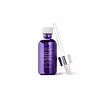What's inside
What's inside
 Key Ingredients
Key Ingredients

 Benefits
Benefits

 Concerns
Concerns

 Ingredients Side-by-side
Ingredients Side-by-side

Dimethicone
EmollientCyclopentasiloxane
EmollientCaprylyl Methicone
Skin ConditioningDimethiconol
EmollientDimethicone Crosspolymer
Emulsion StabilisingTetrahexyldecyl Ascorbate
AntioxidantDimethicone/Vinyl Dimethicone Crosspolymer
Skin ConditioningPaphiopedilum Maudiae Flower Extract
Skin ConditioningHydroxypinacolone Retinoate
Skin ConditioningBisabolol
MaskingZingiber Officinale Root Extract
MaskingCaprylic/Capric Triglyceride
MaskingDimethyl Isosorbide
SolventEthylhexyl Cocoate
EmollientGlyceryl Linoleate
EmollientGlyceryl Linolenate
EmollientTocopheryl Acetate
AntioxidantCholesterol
EmollientCeramide NP
Skin ConditioningPhenoxyethanol
PreservativeDimethicone, Cyclopentasiloxane, Caprylyl Methicone, Dimethiconol, Dimethicone Crosspolymer, Tetrahexyldecyl Ascorbate, Dimethicone/Vinyl Dimethicone Crosspolymer, Paphiopedilum Maudiae Flower Extract, Hydroxypinacolone Retinoate, Bisabolol, Zingiber Officinale Root Extract, Caprylic/Capric Triglyceride, Dimethyl Isosorbide, Ethylhexyl Cocoate, Glyceryl Linoleate, Glyceryl Linolenate, Tocopheryl Acetate, Cholesterol, Ceramide NP, Phenoxyethanol
Cyclopentasiloxane
EmollientCyclotetrasiloxane
EmollientDimethiconol
EmollientIsopropyl Palmitate
EmollientGlyceryl Dibehenate
EmollientTribehenin
EmollientGlyceryl Behenate
EmollientRose Extract
Skin ConditioningVitis Vinifera Fruit Cell Extract
Skin ConditioningTetrahexyldecyl Ascorbate
AntioxidantRetinyl Palmitate
Skin ConditioningAscorbyl Palmitate
AntioxidantTocopheryl Acetate
AntioxidantSimmondsia Chinensis Seed Oil
EmollientPersea Gratissima Oil
Skin ConditioningOlea Europaea Fruit Oil
MaskingCocos Nucifera Oil
MaskingPhenoxyethanol
PreservativeEthylhexylglycerin
Skin ConditioningParfum
MaskingCyclopentasiloxane, Cyclotetrasiloxane, Dimethiconol, Isopropyl Palmitate, Glyceryl Dibehenate, Tribehenin, Glyceryl Behenate, Rose Extract, Vitis Vinifera Fruit Cell Extract, Tetrahexyldecyl Ascorbate, Retinyl Palmitate, Ascorbyl Palmitate, Tocopheryl Acetate, Simmondsia Chinensis Seed Oil, Persea Gratissima Oil, Olea Europaea Fruit Oil, Cocos Nucifera Oil, Phenoxyethanol, Ethylhexylglycerin, Parfum
Ingredients Explained
These ingredients are found in both products.
Ingredients higher up in an ingredient list are typically present in a larger amount.
Cyclopentasiloxane, or D5, is a silicone used to improve texture of products and trap moisture.
D5 is considered lightweight and volatile. Volatile means it evaporates quickly after application. Once evaporated, D5 leaves a thin barrier that helps keep skin hydrated.
It is also an emollient. Emollients help soften the skin and prevent water loss. Silicones create a silky texture in products. D5 helps other ingredients become more spreadable.
Studies show D5 is safe to use in skincare products. We recommend speaking with a skincare professional if you have concerns.
Learn more about CyclopentasiloxaneDimethiconol is a silicone that resembles the popular dimethicone. Like other silicones, it is an emollient. Emollients create a thin film on skin to prevent moisture from escaping.
This ingredient helps to create a silky texture and improve spreadability. Due to its high molecular weight and thickness, it is often combined with cyclopentasiloxane.
Phenoxyethanol is a preservative that has germicide, antimicrobial, and aromatic properties. Studies show that phenoxyethanol can prevent microbial growth. By itself, it has a scent that is similar to that of a rose.
It's often used in formulations along with Caprylyl Glycol to preserve the shelf life of products.
Tetrahexyldecyl Ascorbate (THD) is a stable and oil-soluble form of Vitamin C.
THD is special in that it has the ability to travel deeper into skin than traditional ascorbic acid while maintaining the same skin benefits (double win!).
Because it’s oil-soluble, THD dives deep into your skin’s fatty layers (think ceramides and cholesterol) to fight off the kind of free radicals that mess with your skin barrier. This makes it a great pair with water-based vitamin C (ascorbic acid) that mainly works on the surface.
Even at just 0.1%, THD is already showing great antioxidant activity. When used up to 2%, it helps keep your skin happy and calm, especially when it’s stressed from pollution or sun.
Want to fade dark spots or tackle hyperpigmentation? You’ll want 5% or more. Pairing it with brightening buddies like niacinamide or licorice root gives even better results. One study even used 30% THD with other brighteners and saw real results on stubborn discoloration, even in melasma-prone skin.
A note on THD: It’s has a slightly silky, oily texture and usually shows up colorless or pale yellow (though the exact shade can vary by supplier).
While you can sneak it into water-based formulas, it really shines when paired with silicones or oils, which help your skin soak it up better.
THD is pretty stable, but it’s still vulnerable to degradation like ascorbic acid. Too much light or heat (above 113°F / 45°C) can break it down over time. Go for dark and opaque packaging that keeps it safe and shady!
Read more about other types of Vitamin C:
Learn more about Tetrahexyldecyl AscorbateTocopheryl Acetate is AKA Vitamin E. It is an antioxidant and protects your skin from free radicals. Free radicals damage the skin by breaking down collagen.
One study found using Tocopheryl Acetate with Vitamin C decreased the number of sunburned cells.
Tocopheryl Acetate is commonly found in both skincare and dietary supplements.
Learn more about Tocopheryl Acetate